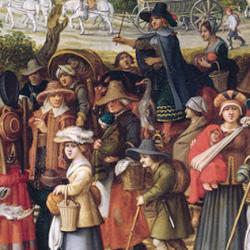Joan Cadden’s Nothing Natural is Shameful is many things: A careful study of the medieval reception and use of various Aristotelian texts; an analysis of medieval natural philosophy and ethics and the relation between the two; a contribution to research about Western views of sodomy; a study of medieval notions of masculinity and femininity.
She takes her title from the claim of Walter Burley that “nothing natural is shameful,” and examines how various writers – Pietro d’Abano, Jean de Jandun, and Burley tried to apply their understanding of natural philosophy to the problem of sodomy: Why is it that some men seem to find anal stimulation pleasurable? She sets these writers in a rich scholastic context, frequently noting their agreements and divergences from Thomas.
I’m sure Cadden has an agenda, but her book is a careful work of textual scholarship, dispassionate in tone and methodical in exposition.
One of the more intriguing issues she uncovers is the tension between different conceptions of nature, and the problem of explaining how “unnatural” conduct could apparently become “natural” to certain human beings.
Some men are physically deformed, and thus inclined toward sodomy because of a defect of nature. Another explanation was to invoke habit, formed by pleasure, memory, and desire, which becomes so ingrained that that they appear to be natural. Thomas speaks of habit that is turned into nature, though “by accident” (173). Another explanation was to distinguish the generic nature of human beings from the specific nature of an individual. Overshadowing the whole issue is the question of moral responsibility: If some men are “naturally” inclined toward vice, are they responsible for their actions? So the effort to provide a “scientific” explanation for sodomy gets entangled in the Augustinian problematics of the will.
For many of the thinkers she discusses, natural philosophy was a distinct subject from ethics. It was possible to explain philosophically and “scientifically” why certain men do what they do, but that was a distinct issue from judging the moral status of their actions.
Yet natural philosophy and ethics get mixed. Cadden writes, “The distinction between ‘natural’ in the full, universal sense and ‘natural’ in a more individual and contingent sense is . . . found not just in natural philosophy but also in ethics. And it is what made it possible for medieval readers to accept the notion that there existed individuals whose natures produced behavior that, no matter how appalling, was not vice properly speaking and was therefore not subject to moral blame properly speaking” (151). Following Aristotle, some were pressured toward the conclusion that “some abominations were beyond the reach of moral condemnation” (174).
The intrusion of natural philosophy into ethics was, in fact, condemned by the Condemnations of 1277, which rejected “nature from intruding on the regulation of morals and . . . likewise bars natural philosophy from interfering in matters pertinent to salvation” (174). It was a detestable error to say that “the sin against nature, in particular the abuse in the course of coitus, although it is against the nature of the species, is not, however, against the nature of the individual” (174). As Cadden warns early on, medieval notions of “nature” are not identical to early modern notions of “natural law.”
I am summarizing only a slice of Cadden’s complex book, but it’s the one with the most contemporary relevance. It shows that current conflicts about the role of “nature” in the moral assessment of human sexuality have been around for some time, and it suggests that, given the ambiguities of “nature,” it’s not likely that appeal to nature can be decisive.















